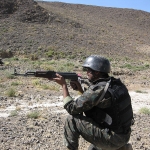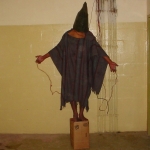Private Company Manages Daily Bombing of Korean Village

MAEHYANG-RI, SOUTH KOREA - Six days a week, up to 16 hours a day, the skies above this tiny fishing village, fill up with F-15, F-16, and A-10 fighter jets, that hurl bombs at a small island less than a mile away from the community.
The pilots come from United States military bases across the Pacific - as far north as Japan and Okinawa to Thailand in the south and Guam in the east, to this rural region just 50 miles south of Seoul on the west coast of the country.
This has been the arrangement since August 1951, when US troops took the area from North Korea during the Korean War and then set up the practice bombing range unilaterally without consulting the South Korean government.
But today the Maehyang-ri bombing range isn't run by the US Air Force and it isn't run by the US Army. Five years ago, the bombing range was privatized and its management turned over the multinational weapons contractor Lockheed Martin. Then, in July, the bombing range changed hands. An Alaska-based company called Arctic Slope World Service took over the contract.
Affirmative Action Contractor?
The company is on the Fortune 500 and boasts annual revenues of more than $1 billion but Arctic Slope isn't your average weapons contractor.
In some respects, its similar to big contractors like Halliburton or Lockheed. When the company won the contact for Maehyang-ri, it already had already managed parts of American military installation across the country from maintaining the Army's AH-64 Apache, UH-60 Black Hawk, and UH-1 Huey helicopters at Godman Army Airfield, Fort Knox, Kentucky, to running the 600 unit housing complex at McConnell Air Force Base near Witchita, Kansas. Arctic Slope even managed Midway Naval Air Station in the Pacific until the military closed the base in 1997.
But in other respects its quite different. Arctic Slope's history dates back to 1971 when Congress passed a law turning over some of Alaska's land to companies nominally owned by Inupiat Eskimos. At the same time, the government bypassed recognized tribal governments. As a result, native claims to almost all of Alaska were extinguished.
The Arctic Slope Regional Corporation (ASRC) represents eight villages above the Alaskan Arctic Circle and the company website claims that: "By adhering to the traditional values of protecting the land, the environment and the culture of the Inupiat, ASRC has successfully adapted and prospered in an ever changing economic climate."
Anti-Union Policies
Villagers and workers here in South Korea disagree. When Arctic Slope took over at Maehyang-ri in July, the company's first act was to fire all the workers and make them reapply for their old jobs. More than a quarter of the Korean employees weren't hired back.
Forty nine year old Kim Ka Chan worked as a guard at the bombing range more than a decade. "I have a wife and four children," he says, a listless look in his eyes. "I had a good job fourteen years. Now we have to live off the money my wife makes running a small illegal food stand. It's very difficult."
"We're just people who need to work like everyone else," he says. "We have families we need to support and things we need to pay for. Arctic Slope should think about that."
But there's no union for the workers at Maehyang-ri and Arctic Slope has made clear it doesn't want one. When one of the fired workers complained to Korea's premier labor union representing defense industry workers, he was given a new job but at another company on the other side of the country.
Under the Status of Forces Agreement that governs relations between the U.S. military and South Korea, American military contractors are not required to follow local labor laws. Pak Sang Ki is regional chapter President of the United States Forces Korean Employees Union, which represents most Koreans who work the American military.
He says the company claims its bid was so low it couldn't pay 23 Korean workers $1,400 dollars a month, but he's quick to add his union has never seen Arctic Slope's contract with the military.
"There's no way to find that kind of information," he explains. "Arctic Slope's contract was classified. They just told us that the jobs were changing and that they were cutting back."
Land Seizures
The base workers are not the only people who have been impacted by this military base. From the very beginning the United States military has taken advantage of the local community.
Sixty seven year old Che Chu Pin remembers when the US Army took his family's farm in 1951. A year later, an American practice bomb landed on his sister.
"In 1952 when my younger sister was ten years old, he says. "She was looking for oysters on the beach. There was an Island called Koon-Ni Island then but it is all gone now because it has been bombed so much by the Americans. She was working when the American airplane dropped a bomb that ripped through her leg and her thigh was destroyed. Since then, she has been lame. One leg is longer than the other."
Che Chu Pin also blames the American Army for his son's disability. He says his son was playing with a slingshot around toxic residue from the bombing when some of the residue got in his eyes. His son has been blind ever since.
Farmers that have resisted the occupation have also had their land taken away. "I had a farm," recalls 87 year old villager Choi Sun Sup. "I planted lettuce and one day the U.S. Army was driving on my farm and I got upset. And I hit the soldier in the head with a rake. And the soldier pointed a gun at me. ... Anyway, I don't have a farm any more. It was six square kilometers, but the government took it from me."
Toxic Pollution
Before the bombing range opened the main business for most residents was fishing and digging for clams. But residents are barred from clamming during the bombing, the vast majority of daylight hours.
Meanwhile the targets for the bombs are islands in the beautiful bay, not far from where the community derives its livelihoods by fishing. One entire island has already been wiped out while another two mile long island has been reduced to two-thirds its original size.
When residents of Maehyang-ri are able to look for clams the ones they find are polluted by the bombing. A study of Maehyang-ri shell-fish commissioned by the environmental group Green Korea found toxic levels of cadmium and copper and 145 times the amount of lead in the shell-fish than there should be. But villagers say they have no economic choice but to keep fishing since its the only way they can make their livelihood.
Green Korea's Lee Yo Jin recalls sharing her groups study with the villagers. "They said but we have to live here and we have to eat the shells and fish from the sea and we have to sell it. 'Yeah, I know, I'm sick, they would say. But if we reveal the pollution we will lose our way of life, so please lets handle this problem step by step."
Not all the bombs hit the islands - thousands can be found in the hillsides surrounding the area while people's homes have often been struck. Windows, walls and roofs have been badly damaged by the bombing while at least 12 people have been killed and numerous others wounded by bombs that went astray.
Protests
Local residents have protested many times, ranging from flying kites to distract the low flying pilots, and by putting their bodies in front of the bulldozers to prevent new construction when the base was first created.
On December 12, 1998, a group of villagers submitted a petition protesting the noise pollution from the firing range. When the government ignored the petition, about 1,500 villagers occupied the bombing range, including the islands. Today the villagers have filed suit at the Korean Supreme Court demanding $10,000 in compensation per resident for the damage inflicted by 50 years of bombing.
Note: Arctic Slope and United States military spokespeople did not return numerous phone calls from Corpwatch seeking comment.
Aaron Glantz is a correspondent for Free Speech Radio News.



